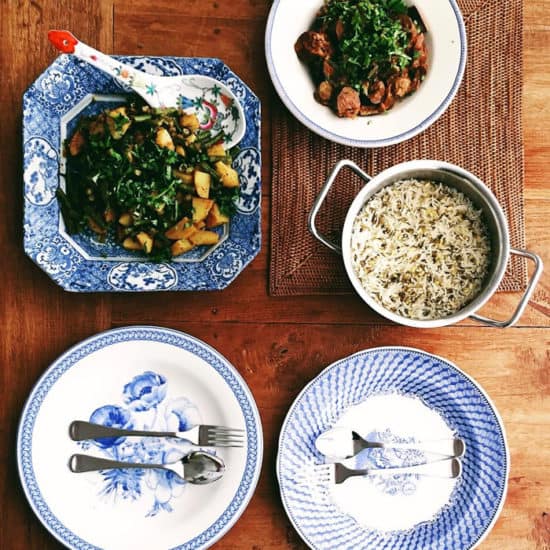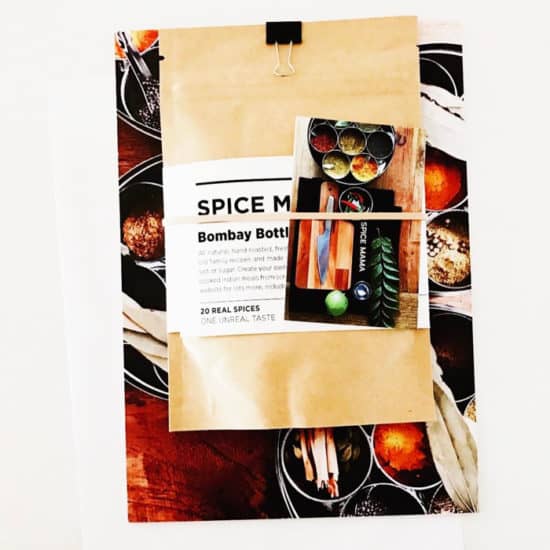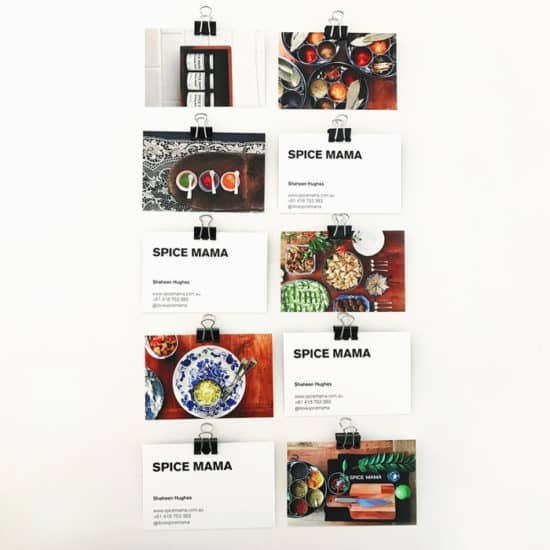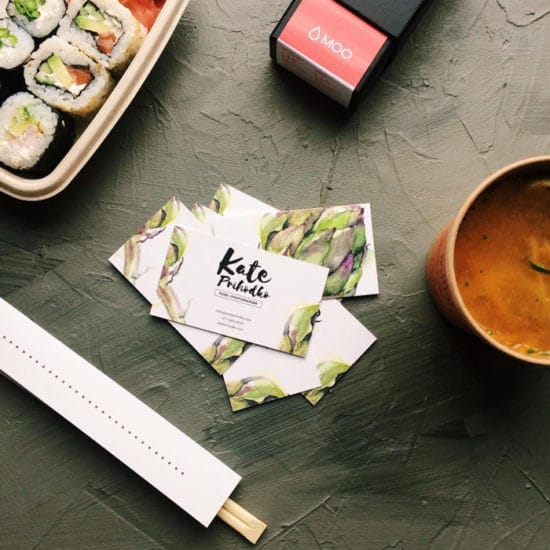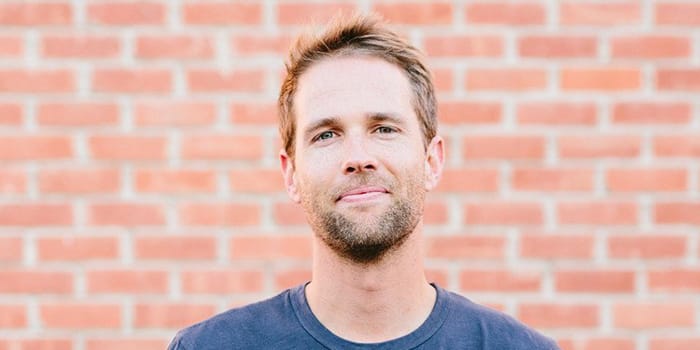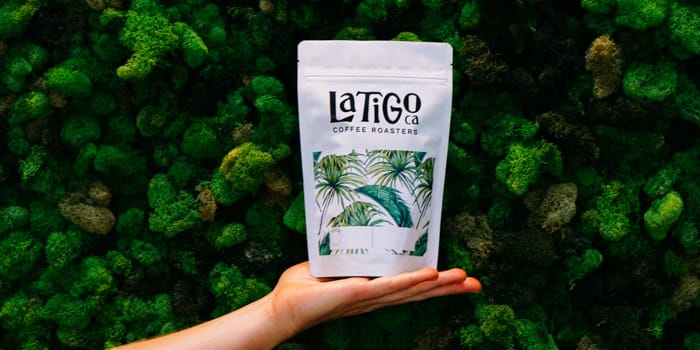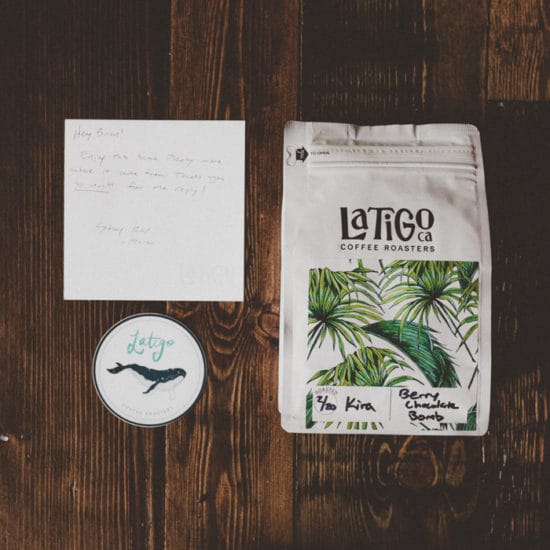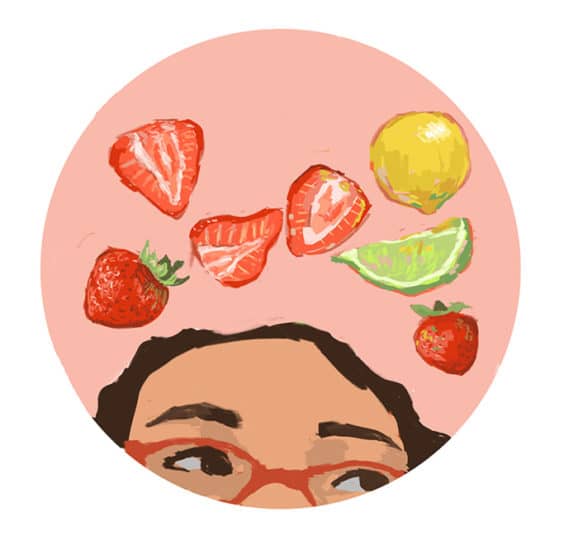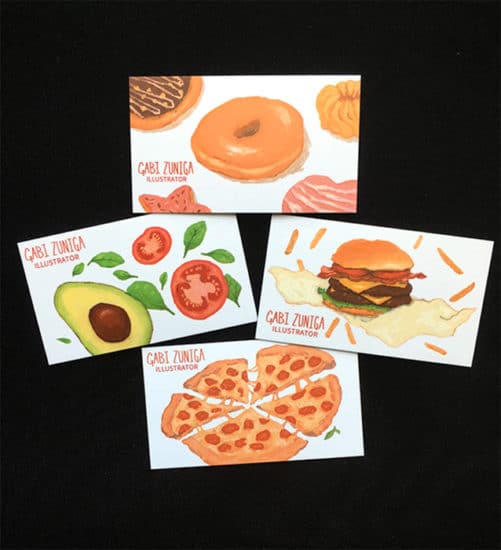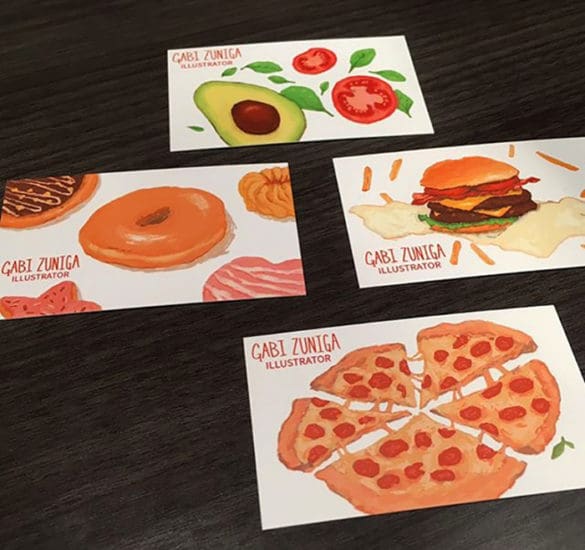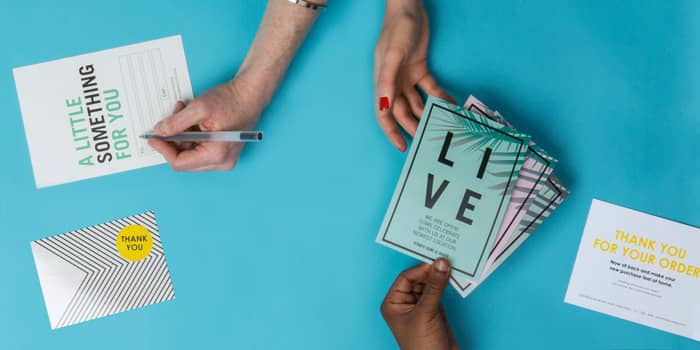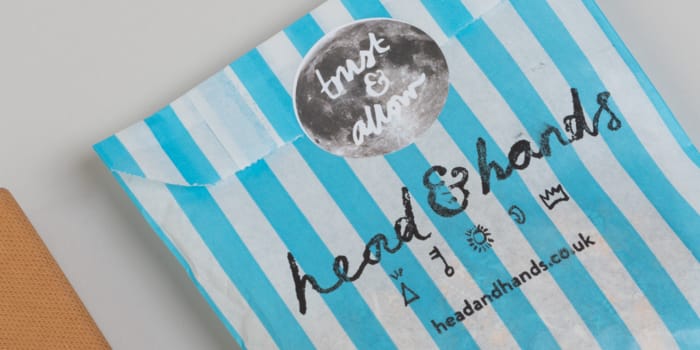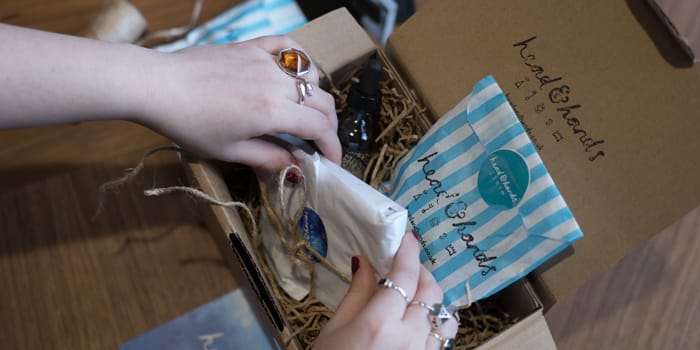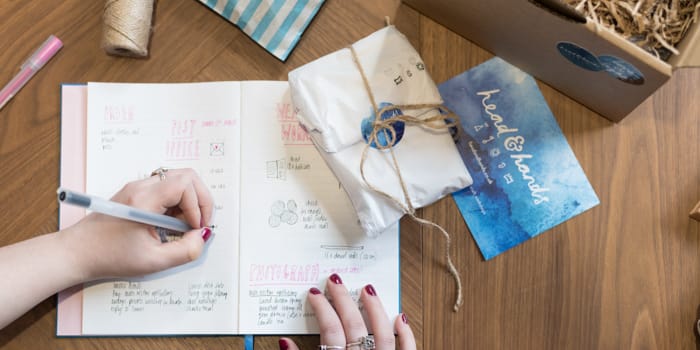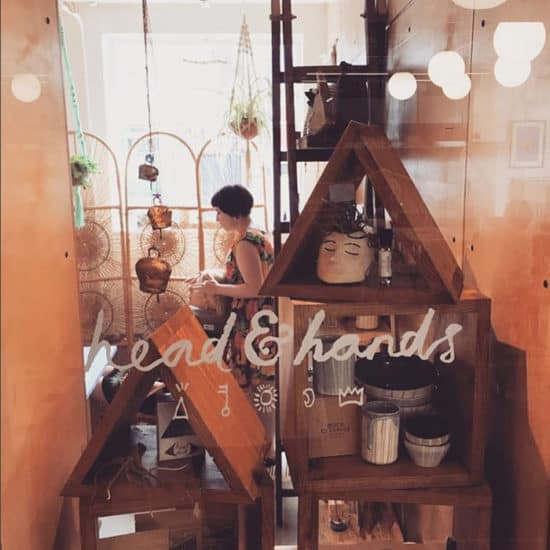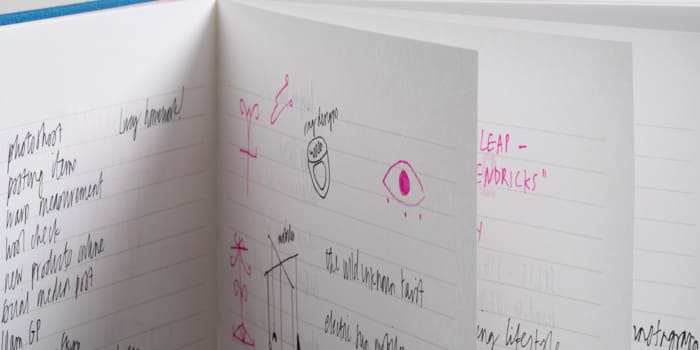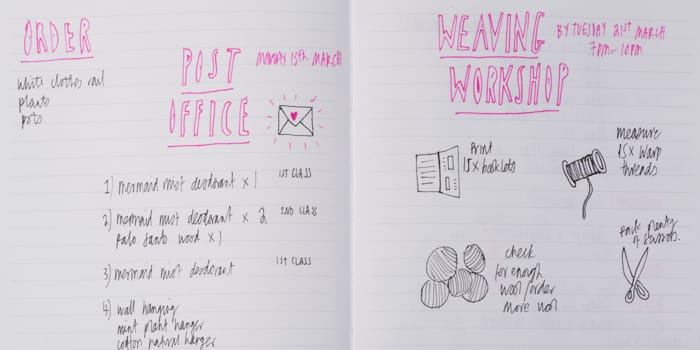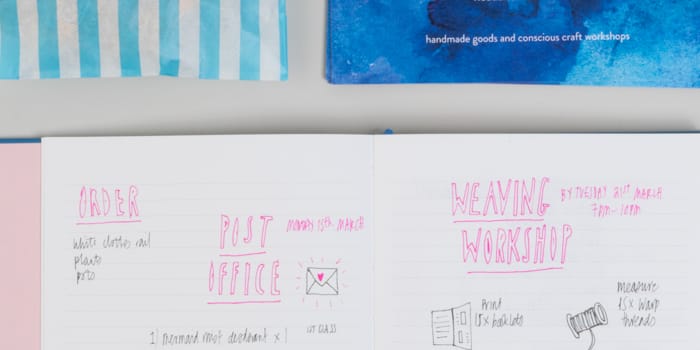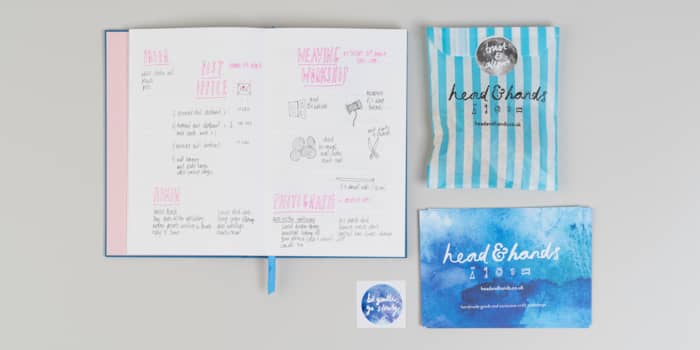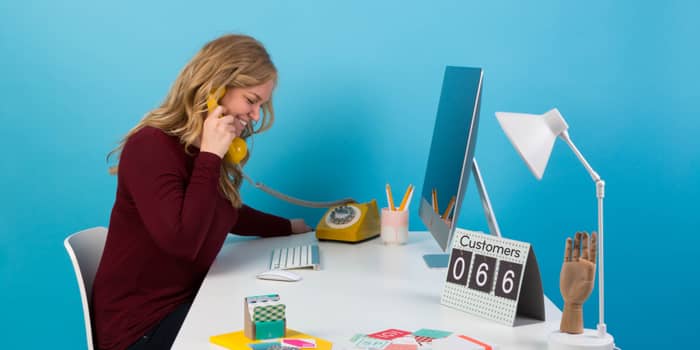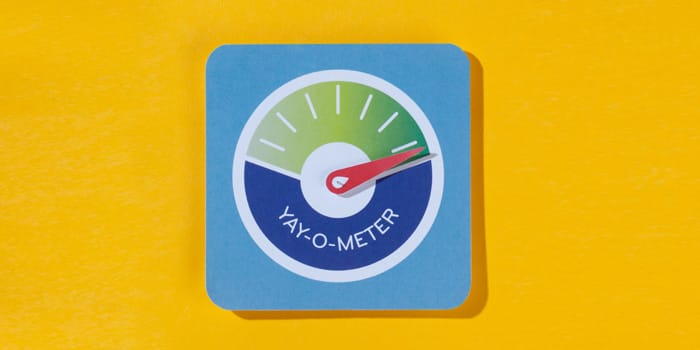A recipe for a successful business
Victoria Eggs, a British-themed homeware designer, is the true definition of an entrepreneur. She found her niche, self-funded her business and is just about to take on her first employee. So, what’s her recipe for success?
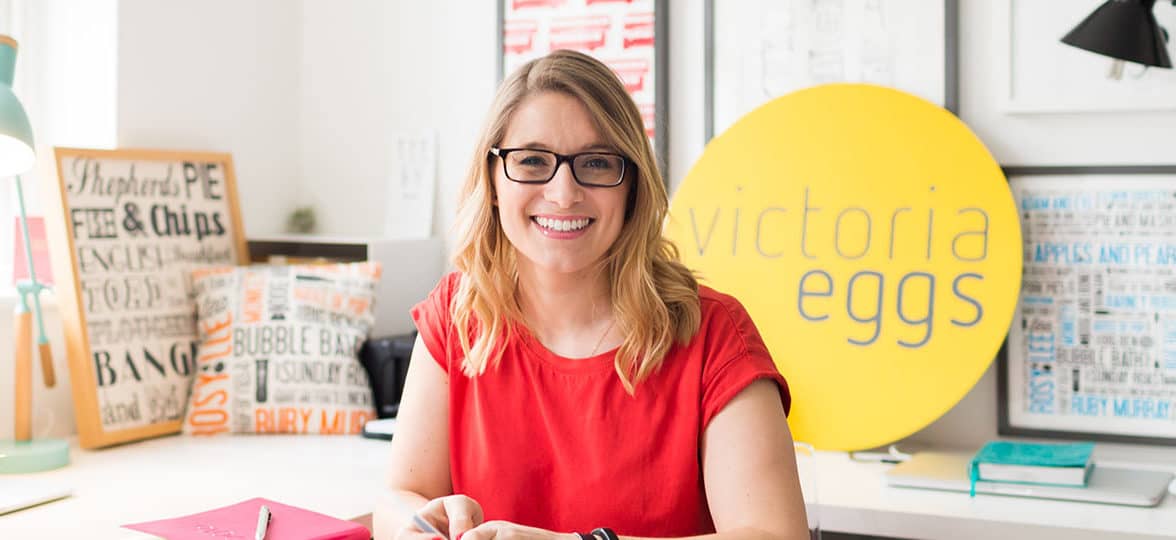
Victoria Eggs, a British-themed homeware designer, is the true definition of an entrepreneur. She found her niche, self-funded her business and is just about to take on her first employee. So, what’s her recipe for success?
Victoria Eggs is one of the most ambitious entrepreneurs you’ll meet – she also happens to be just as nice as she is ambitious. If we were to describe her by her name, she’s most definitely sunny-side-up.
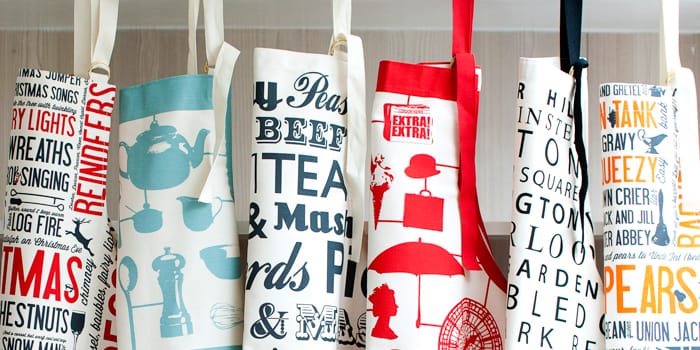
From Cockney-themed tea towels to an English-dinner-themed apron, Victoria’s award-winning, whimsical products are sold globally and have also been featured in magazines closer to home, such as Elle Decor, Marie Claire, and House Beautiful.
We sat down with Victoria to find out how she manages to stay focused while steadily growing her business on her own—and of course, how it all began.

How did you find your niche designing British homeware?
I was designing for Ben Sherman in Australia, working on iconic British patterns like Brighton Beach. Naturally, over time, I built up a portfolio of designs that weren’t really suitable for Ben Sherman, but being away from home, the designs tugged on my heartstrings. Even the simplest of designs like a cup and saucer just felt so nostalgic and iconic and I knew I wanted to do something with these designs.
When I came back to London in 2010, I had a choice to find a job—any job, or start my own business—and starting my own business was something I’ve always wanted to do. It needed to be something creative, that also combined my love of project management. And that’s when I decided to take the plunge.
What inspired the heart of your brand?
It’s always been a British-inspired brand designed to celebrate my love for all things British through nostalgic, fun and playful patterns.
As time went on, it seemed only fitting and right that the products were made in Britain, too. So, the brand has now evolved to a place where “Made in Britain” is the core of the brand as much as—if not more than—the inspiration behind the design.
How did you fund your business when you were starting out?
It’s been completely self-funded – which is why it’s grown at a slower rate compared to a lot of businesses – there’s been no investments.
I was always a real saver when I was younger and worked part time jobs throughout uni. I was always saving up for something and I continued to save while I was living in Australia by working two jobs out there. When I returned to the UK, the exchange rate was in my favour, which was lucky.
I’ve had a few cash flow issues more recently – it can be tricky when lots of people are ordering products – you don’t get paid for 60 or 90 days. My wonderful dad has helped me out with little bridging loans in between and I also have a fairly decent overdraft from my bank when I need it.
Have you taken on any employees since starting your business?
I’m taking on a full-time sales person which is incredibly exciting! I can’t wait for them to look after the customers we’ve got and to go out and find new ones. This role will help me grow the business in line with the ambitious but realistic targets I’ve got set for 2017 and 2018.
It’s taken me a little while to work out the perfect role for an employee, but now that I’ve seen where I spend my time and what brings in the money, I think this is the right position to start with.
I have a clear idea of our monthly sales targets and the breakdowns of those targets, along with which retailers and locations we should be focusing on – we’ll be able to track and monitor the success together.
When you’re self-employed, it can be very difficult to do everything—marketing, sales, managing customers, replying to emails—there’s just not enough time in the day, however organised you are and I have to remind myself of that sometimes.
How do you market your business?
I use Facebook and Instagram. I’m a visual person and my products need to be showcased on visual platforms – these channels are perfect for showcasing my brand and product images on a personal level.
I also send out weekly email newsletters to customers along with a monthly email newsletter to wholesale customers.
Are your sales mainly within Britain, or are they international?
I sell products in America – we supply several shops. I also sell in Asia, and Australia, and to expat communities. Basically, to people who simply love Britain and British-ness.
So, how much of your business is B2B vs. B2C?
B2B is about 80%. I’ve introduced the new sales role so that they can focus on the B2B side whilst I try to boost the B2C side of the business.
I’ve got lots of plans for the new website, and a whole new marketing strategy which includes email newsletter campaigns, social media advertising, and paper mail outs to customers that have ordered before.
How do you stay organised and focused?
You can get really bogged down in the minutiae—by the emails pinging the corner of your screen all of the time—but I think it’s really important to remain focused on that one target you have for that day or week and block your time and focus on things that matter to you, rather than letting other people’s priorities become yours.
My “to do” list and “done” list is broken down into a chart that has “urgent/not urgent at the top and important/not important” at the bottom. It’s a real life saver!
I put everything on little post it notes—so it’s really easy to move and prioritise tasks, unlike a normal list. I have everything I want to do on the left side of the board, and as I’m doing it, I move it across. It’s also a really good way to get everything out of your head, and you know you’re not scratching around thinking “oh, have I remembered that?”
By the end of the week, I aim to have all the post-its on the right side, it’s real visual “well done”—which is nice, because you don’t often get a “well done” when you’re working by yourself.
How else do you reward yourself as you typically work alone?
Every time an order comes through and a retailer or customer says “I love your products!” or “We want orders,” or, “We want samples”—I give myself a pat on the back and say, “Yeah, OK, I’m doing something right.”
And it’s so easy—I’m guilty of doing this myself—to always look at where you want to be next month or year, and always strive for that next goal. But it’s really important to take a step back to reflect and say “Well done,” too. Treat yourself with whatever you feel a nice reward is and make note when you’ve done something good, and hold on to it for a little while.
We <3 the MOO community! Every day, we’re inspired by people all over the world who’ve built a brand from their own creativity – we think you will be too.
As far as we can tell, Instagram’s fuelled almost entirely by the kind of food photography that makes us wish it was lunchtime already. And of course, a lot of these plates come from the awesome entrepreneurs we’re lucky enough to count among our customers. Meet 4 of our hottest food industry brand-builders – and see how they built their business (and designed such mouthwatering cards).
Spice Mama
Spice Mama, founded by Shaheen Hughes, is a traditional Indian food and recipe project designed as a tribute to the women in her family. Shaheen hand-makes spice blends passed down through the generations, translating hand-me-down recipes that she shares in pop-up cooking classes in her hometown of Perth, Western Australia. Woah!
Shaheen told us: “Indian food is one of the oldest cooking styles in the world. There are thousands of years of knowledge about using food as medicine, and how to eat for your well-being.” This practice, handed down through generations of women, is exactly what Shaheen wants to keep that alive. She adds, “I want to make traditional, home cooked food look beautiful, and full of the love with which it has been cooked”.
Shaheen designed her cards with Printfinity – so she can show a range of her favourite images. “Indian food is all about a multi-sensory experience,” she says. “An explosion of colours, flavours and textures – you have to engage with it visually to really appreciate it”.
She printed her cards with a matte finish, and explains: “I love the smooth texture and strong stock quality, they are so tactile and really make my images stand out. The cards embody what I want to say about my brand – strong and simple, colourful, beautiful and full of passion. They help emphasise the sensory connection I want people to feel about food. It’s sometimes hard to describe a thousand things you want to say about your brand, but I can give people a card and it communicates the lot for me”.
Shaheen adds that if she could make one improvement to her cards, it would be to make them scratch and sniff: “I would get them to the smell aromatics, like cinnamon, cardamom and cloves”. Yum!
Get Business Cards that speak for you
Kate Prihodko
Kate Prihodko is a food photographer from Riga, Latvia, currently living and working in Tallinn, Estonia. Kate’s business started with a blog where she shared recipes that she’d created along with beautiful photography to accompany them. After about a year, she branched out into photography for restaurants and enjoyed it so much that she decided to grow her business in that direction.
Now, Kate’s work is focused around photography for restaurants, bars and magazines. She also does some advertorial work while continuing to write her own recipes.
Of course, Kate’s business cards had to be focused around food – her biggest inspiration. The hardest decision was whether to feature asparagus or artichokes on her cards – two of her favourite foods. She went for artichokes – great choice – and her friend Tomas, a designer, helped her with the illustrations.
Kate’s cards have a matte finish: “I like to go with classic finishes. I was so happy to see the end result – I love my paper and finish choice and my cards fully represent me and my business.”
Get your own Matte Business Cards
Latigo Coffee
Latigo Coffee is a subscription-based delivery service based in Los Angeles. With a background in coffee farming and eCommerce (a not-too-common pairing), the founder Mark aims to share the most exciting coffee stories from around the world with their community.
It all started in 2012 when he quit his desk job and moved to Hawaii to work on a coffee farm. In the 5 years since, he’s travelled the world in search of the finest coffee experiences. The idea for a coffee subscription (named after Latigo Beach in beautiful Malibu, California) came to Mark during a long bicycle tour of the CA coast last year.
As Latigo Coffee is only available via an online subscription, the packaging and unboxing experience is a huge priority. Having very little experience in design, Latigo reached out to their favorite Instagram doodler, RJ Rabe and shared the “vibe” they were going for. Together, they settled on the “Tandem” idea (the old-school Hawaii surfing design, which involves a Chemex coffee maker).
Latigo have printed the design onto Square Flyers – they get sent out with every customer’s first shipment. Mark adds, “the flyers were the perfect fit (literally) for our packages. They fit snugly with our shipments – each one features the Tandem design on the front, and we handwrite a thank you message on the reverse side for each customer.”
“Being a small bootstrapped operation, high-quality inserts go a long way. It’s funny how little things like these “thank you” cards (and our custom packaging tape from Lumi) can add so much value to the brand, even though we’re a tiny operation. People love receiving handwritten notes and our unboxing experience is integral to the business.”
Let your packaging tell your story – make your own flyers
Gabi Zuniga
Gabi Zuniga is a freelance illustrator specializing in food. Her aim is to enhance and stylize her subject, showing off it’s most interesting features whilst still maintaining the familiarity of the food we all know and love.
When it came to creating her business cards, Gabi wanted to place the food at the forefront, drawing people in with her eye-catching, appetizing designs. “I love being able to hand prospective clients and the people that I meet a card that I feel good about”.
Gabi uses Printfinity on a matte finish to showcase her portfolio: “Being able to get multiple designs on the backs of the cards was big deciding factor for choosing MOO. I love watching people try to choose between which design they love the best – people treat my cards like collectibles”.
Showcase your portfolio with Printfinity
Everyone loves flexible working – it fosters trust, engagement and, ultimately, happiness. But how can you maintain a strong brand with employees all over the world? Follow our 5 tips.
As the 34 million Americans who work from home according to Forrester prove, remote working works. But how well?
There’s no question that employers can access a wider pool of expert applicants and keep their team more engaged if they give them freedom-of-movement and location. Some studies even suggest that they’re more productive this way: remote working eliminates common drags on in-office productivity like noisy co-workers and impromptu meetings, according to Hubspot.
Yet with workers literally all around the world, there’s a danger that what’s gained in efficiency might be lost in camaraderie, which is a huge key to success.
As an entrepreneur, how do you balance flexibility and still foster a vibrant company culture?
1. Have a powerful common cause
According to the Harvard Business Review, “A great culture starts with a vision or mission statement. These simple turns of phrase guide a company’s values and provide it with purpose.” Without such a mission, teams lose central focus and harmful divisions form.
Just ask the 70% of people in the global workforce who, according to Forbes, don’t know their company’s own mission statement. It’s little wonder that in a Gallup poll last year, 87% of workers worldwide did not feel engaged in their jobs.
To combat this and build great culture, give your company something to stand for that’s bigger than money. It can be a social, environmental, humanitarian, or even idealistic. Retail brand Life is Good stands for “spreading the power of optimism.” Twitter wants “to give everyone the power to create and share ideas and information.”
Do your remote workers know what your business stands for?
2. Communication
There’s no better way for employees to get to know each other than good old-fashioned communication, and it’s up to leadership to set the example.
“Every successful CEO makes a special effort to get to know his or her team as individuals,” says Alexandra Levit, author of Inspiration at Work, who studies the factors behind great culture. “Show interest in your constituents’ (can include employees, partners and customers) lives and be willing to share some details about yours. The lower your pedestal, the more they’ll rally behind you.”
Communicate frequently and openly and encourage your employees to build relationships with each other as well. Chat tools like Slack can help by making communication not only easier, but also fun.
3. Meet when and where you can
Just because your employees are remote doesn’t mean that you can’t gather occasionally. Putting names to faces has the power to cement bonds that last a lot longer than the actual gathering.
According to Emil Skandul, founder of the U.S.-based digital design agency Capitol Foundry which has employees across Europe, “Meeting in-person is critical. As a company, every year, we choose one of our remote employees’ countries and we all fly out there for a visit. The impact on team morale is invaluable – worth so much more than the plane tickets.”
Do as Skandul does and if it’s practical, plan an annual meeting, a summit, or just a party to celebrate what you’ve accomplished together.
4. Show recognition and appreciation
As Maya Angelou so eloquently put it, “People will forget what you said, people will forget what you did, but people will never forget how you made them feel.” Positive recognition is something that people just don’t get enough of even in the best of times and showing your employees how much you appreciate them can build serious goodwill towards the company and help solidify that relationship.
In our experience, recognition is best done with a personal touch. Think less “gold watch with company logo” and more thoughtful, spontaneous gifts: say thanks often, post about their success on social media, offer additional perks, create an award, or grant them a bonus that helps them pay for something happening in their life, like a vacation or their children’s braces.
5. Strong print branding
Unify your global business with more than just a website – give it a physical, tactile appearance with powerful letterhead and bespoke business cards. These give your employees a physical touchpoint with the brand and the sense that no matter where they are in the world, they’re part of a well-run business that’s much bigger than the sum of all its admittedly excellent parts.
Great culture is always possible with any workforce! You just need to build great communication around a common cause and cement it with recognition and branding. Do this, and you’ll be able to harness the power of flexible workers without sacrificing the benefits of a powerful company culture.
Strengthen your branding with Business Cards
Growing a business is about more than a strong product – it’s about finding a big idea, a motivation that keeps you going. We met Amanda Wayne, founder of online self-care sanctuary Head & Hands to find out how she did it (and why she loves her MOO Notebook).
Small businesses with big hearts, those with purpose rather than product as their engine, have a stronger opportunity to flourish in today’s online economy than ever. We’re always delighted to find, among our community, those entrepreneurs who’ve set out not only to build a business, but to bring to life an idea. London-based entrepreneur and designer Amanda Wayne was driven to start a business, Head & Hands, with a strong idea about wellbeing at its heart.
What does Head & Hands do?
Head & Hands is a three-armed business. First, it’s a curated store of handmade products. Second it hosts conscious craft workshops run by me or guest artist makers. And the third thing is actually what started me off in the first place – Indian head massage.
The name ‘Head & Hands’ is all about making a connection with yourself – keeping your hands busy and your mind happy. I try to find ways to help people pause, be with themselves and feel happy and relaxed.
Where did the idea come from?
I have some chronic health issues, and I found myself seeking more holistic help for my illness. The place that I realised I needed to start was in making space to relax. I went to see a facial reflexologist – yes, like on the feet, but on the face! It was incredible! She really sorted me out, but she also had this amazing space. It was a real sanctuary.
We’d have incredible chats when I went in for a treatment and I felt very listened to and cared for. That’s when I started to think a lot about how I wanted to do something similar, but involving my background in art and making too. So I did a course in Indian head massage, which also brings together the relationship between head and hands.
How did your background in design lead you here?
Prior to Head & Hands, I was working for a design studio, doing a lot of community engagement work, running creative workshops. I worked with communities where there was going to be something changing – I helped them shape some of the design decisions that were being made in their environment.
I studied graphic art and design at university, then started working in schools, bringing together my art experience and working with people. People have always been at the centre of what I do, which is what led me to realise that there’s actually something really interesting about what happens to people when they’re making. It’s the soothing power of craft. I’ve worked with quite vulnerable people who can just transform when they’re learning, making and working with their hands.
After I first set up my business after university as an illustrator/graphic designer, my brand name was ‘With your hands’, because I was really interested in tactile work and the low-tech. I’ve always been about getting away from technology and getting back in your body. Looking back now, I can see all the links with all the jobs I’ve done before – it is all relevant.
How did you find your shop space?
It’s a strange story – I did my massage course, not knowing exactly why, just feeling like I wanted to do something new, then a space became available in my local area, Walthamstow. There was an incubator project running to help start businesses off. So I realised I could pull together not just a massage space, but more than that – I knew artists and makers so I realised it made sense to also be selling some things. Plus I run workshops, it’s what I’ve always done, so why don’t I bring all of these things together?
At this point, I had no furniture, no stock, just an idea on paper that had poured out of me when I wrote the application. I had a name, but it was no more than that – it was just an idea that seemed right.
I found myself in an interview for the space and they offered me it then and there. I only had a month and some measurements to work with – there was a moment where I taped out in my block’s hallway the size of the shop and had to put all my furniture out there to try and see how I was going to fit it all in. The shop was so small!
How did you find your suppliers?
All the products that I sell are focused and selected around self-care, well-being and looking after yourself, as well as celebrating the work of lots of different makers. The rule is that everything is hand-made, and I know a lot of jewellery designers and ceramicists so I had a core range ready made. I’m also a bit of a magpie on Instagram, so I found a bunch more I liked the look of and contacted the makers. Instagram’s a great way for me to find other makers, because it’s so visual and you can get a really clear picture of the ethos.
I gave all of these great makers the idea of this shop that didn’t actually exist yet and asked them if they wanted to be involved – they all said yes! So I started ordering things – like some really unusual products from America’s herbalism scene. They have some people making amazing potions and things you can’t get over here.
How did you mix these disciplines in one shop?
I had no idea how much stock to buy in – I just started buying. And of course, I was on a tight budget. I managed to get friends to help me build furniture and found some amazing things on eBay. I really didn’t think it was going to work out but it just all came together – it felt like a sign. I’ve never done this kind of buying for a shop before, so there were a load of new skills I had to learn.
The launch night was amazing. I’m normally a real procrastinator who can’t commit to decisions quickly but with the shop, I had to be really focused and just get it done. Because it happened at such speed – it happened exactly how it needed to happen.
A lot of people commented that I’d curated it really nicely and it’s that word – curated – that sums up what I really want Head & Hands to become. Positioning myself as the curator of a lot of really curious products and sharing the stories behind them.
When the incubator term ended, how did you try and give the same experience online?
There’s nothing quite like the connection you build up with your customers when you’ve got a physical shop – we’d have some great conversations when they’d come in, there was no urgency to buy and get out, it was about creating a lovely environment to be in.
Online you can’t quite create the same experience, it’s not as tactile, but that’s something I’m learning to work around at the moment. One of the things I’m doing is looking at creating a podcast about some of the makers and their products to make the online space come to life again. It’s an interesting transition.
There is of course the opportunity to pack up and personalise people’s orders though, which I what I’ve been really enjoying. I write everyone a little love note when I post them their box, and I’ve got stickers with uplifting messages on too, so the whole experience of unboxing the products is an act of self-care. It’s the equivalent of me having a lovely conversation with a customer.
You have a lot to balance – how does your MOO Notebook help?
It’s so luxurious – and sturdy! I can be quite clumsy, spilling things on my books and things, and it was nice to have something I was taking quite a lot of pride in. Having the page-protector, having a bit of discipline around having a journal for my own spiritual practice, as an act of self-care.
I’m guilty of spending too much time on my phone and all of those things, and it’s really good to get back in with a really nice book. I really like the lay-flat pages, particularly in the centre section where you can spill a drawing over two pages.
I use it for a mixture of things, as it’s so open to different uses. I use it to write to-do lists, to build a week plan, to sketch out ideas… I can be quite fearful of using books – I usually end up drawing on bits of paper and stapling them together, but this is such a welcoming design, I was unafraid to draw on the pages. It’s got the structure of the lines, but they’re quite faint, which I think is like the book saying to me, “There’s rules if you want, but you can break them.”
Follow Head & Hands
Twitter: @headandhands_
Instagram: @headandhands_
Facebook: headandhandslondon
What are the 2 little words you most want to hear? Now you can carry them with you everywhere – meet our newest collaboration!
You might have spotted the New York artist’s two-word ‘Love Me’ manifesto everywhere from Paris to Istanbul, in collaborations with DKNY, Nike, Pendleton and more. And now he’s teamed up with MOO to put a networking slant on this series. The result? A covetable set of limited edition Business Cards.
Art is firmly rooted in Curtis’ heritage. His uncle is a painter, his father owned a screen printing shop and his brother is a tattoo artist. “I think no one thought it was strange to be an artist in my family” he explains. As well as his artistic family, a move to Los Angeles at the age of 19 opened his eyes to artistic possibilities. And putting them into practice meant taking a few little risks – a tactic that’s served him well ever since: “I would love to say I have a grand plan but the truth is I just keep creating and putting things out there and it’s serving me really well.”
Curtis’ signature ‘Love Me’ campaign is recognized worldwide. You’ll find it appearing on canvas, in metal sculpture, fluid neon, stuck to lampposts in New York City and sprawled on billboards in large-scale collaborations with brands like DNKY and Nike. This two-word manifesto has now become an artistic icon.
We asked him where it began: “It was something I wrote when I was a teenager but I really began putting it out in the world in 2005. Now, more than 10 years later it kind of has a life of its own. For me, it’s the movement of writing the words that I enjoy the most. To the viewer, it’s more the literal meaning of the words. At this point, I like to see how it inspires or affects other people”.
This broad application comes from broad inspiration – he’s influenced by Mark Gonzales, boxing, fiddle fig trees, Cuba in the 1950s, Louis Armstrong, Hermes plates, and Goddard movies. Check out the Pinterest board to see more of this sparkling visual palette.
So, what about his latest collaboration with MOO? Curtis tells us, “this collab is really fun. Essentially I restructured my classic Me along with script sentiments that I think every creative entrepreneur can relate to.
From the casual ‘email me’ to the bold ‘pay me’, it gives a bit of range so you can adapt it according to who you’re meeting with”.
Curtis is an entrepreneur – so much of what he does is focused around finding smart, creative solutions. He adds, “I like MOO because it lets you market yourself in a professional and creative way that’s uniquely your own.”
So, for an artist who puts no limits on his influence or output – what’s his focus now? Two sides of a tactile coin – first up, oil painting, and second, more surprisingly, he’s working with a foundry on a huge, heavy, sculpture series – really different to the pieces he’s worked on before.
Alongside this, he’s working on a short film. After previously getting involved with the Tribeca film festival by donating artwork as a prize, Curtis’ hoping to enter into it as a director next year. We’re super excited to see what comes next – one thing’s for sure, we know we’ll love it.
Arm yourself with 5 designs inspired by Curtis’ iconic ‘Love Me’ artwork
Growing your business? Freelance support can bring you expertise, skill and an extra pair of hands, right when you need them – check out our 6 tips for a smooth and successful time.
By 2020, freelancers will account for 50% of the U.S. workforce, and it’s easier than ever to find and employ them – but what’s the best way to find and work with people who are engaged in you, your business and our clients? Here are 6 tips to guide you through.
1. Get the culture fit right
Culture is critical to entrepreneurial success. In a study by Adam Grant, author of Originals, a book about culture and non-conformity, he found that companies who prioritized culture fit in their hiring practices had a zero-percent failure rate over a 3-year period compared to companies that prioritized talent or skills. In sum, culture is critical when you’re small because it’s the glue that binds your business together.
It’s important to hire freelancers that reflect your brand in the same way your employees do. If they’re late for calls, meetings or turn up with a messy response to a brief, it reflects on you. You want to find someone who is going to be a good fit for your business, culturally. They should believe in the values and goals of your business and should want to be part of the journey – just as much as you do.
During the hiring process, find out more about them and ask questions such as: What’s their own vision for their future? Would they ever start a company and what would it stand for? And of course, what are they hoping that you stand for?
For them to be able to invest in you, you need to invest in them too as you would if they were a permanent employee. Give them the same tech, stationery and business cards that you treat yourself to. This will help them to feel empowered and will enable them to interact with clients and customers in the same way the rest of your workforce do.
2. Set standards for quality assurance
The projects your freelancers work on, and the work they produce are just as much theirs as they are yours – their output reflects on your company. Of course, hiring well is the first step.
Spend the time clearly defining what good looks like so that your freelancers have a model to work off of. Share your brand guidelines, assets and tone of voice documents etc. so that they feel immersed in your business and brand. That way, they will have a better understanding of your visual identity and this will be reflected in their output.
You could also put a lightweight review process in place – you might well find you get a better quality of work from your team by them just knowing you have the process in place.
3. Be clear with your expectations up front
It’s important to set your expectations up front – just as you would with your employees. It will not only help you, but it will also help the person you’re managing. Set project time frames and meeting agendas along with a clear reporting structure.
Share and discuss your values and culture, too. Set up meetings with your freelancers’ peers and have them working closely next to you and the team. This will really help your freelancers to understand how you do things. You’ll find work is completed faster and questions and concerns can be addressed upfront, quickly.
Then, trust them. “Modern leadership is gardening, not chess,” says Ret. Gen. Stanley McChrystal in his business management book Team of Teams.
4. Respect, understanding and praise breeds loyalty
Trust is the foundation upon which all good relationships are built, so whether your freelancer is going to be with you for 2 months, or 12 months, treat them in the same way you would your other employees. Give praise where it’s due and make time to do regular appraisals – nothing motivates quite like knowing that your work is appreciated. As Dale Carnegie, author of the business classic How to Win Friends and Influence People, said “shout your praise from the rooftops!”
It builds goodwill that’ll help you weather harder times, like when you need a favor on a last-minute project. And, you’ll find that people are eager to live up to your expectations, so there’ll be no need to micromanage.
5. Pay your freelancers by project – and on time
Not only will this allow you to manage your budget, but it will also reflect well on your business – everyone likes to be paid on time. Good freelancers appreciate the certainty, and your good reputation will echo through the freelance community. In fact, 50% of freelancers report that income stability is their number-one concern when it comes to going self-employed, according to the Freelancers Union.
Plus, project pay is far more simpler than trying to track hourly work which can be hard to estimate and impossible to keep track of! Freelancing platforms like UpWork and Fiverr have developed time-tracking software solutions to help make both yours, and your freelancers’ lives easier. Phew!
6. Value their careers
Just because someone’s a freelancer, doesn’t mean they don’t have a career path or goal. According to the Freelancers Union just 27% are moonlighting to supplement their income or experience while at a full-time position. The rest see this as a stepping stone to building their own business or attaining their next position.
Treat your freelancers as you would your own employees. By respecting and helping them along their path, you’ll forge a bond that’ll deepen their investment in your company and your customers.
Play to their strengths and give them a good mix of work. Freelancers are just as talented as the rest of your workforce so don’t just give them the projects that no one else wants to do.
Managing freelancers sounds easier than you thought, huh? A relationship with your freelancer is like any relationship – they take work. If you invest in them, they’ll invest in you, they’ll stick around, and they’ll help you scale your business efficiently.
Make sure your freelancers have their business cards at the ready
It’s often been thought that you can’t turn an artistic hobby into a profitable business. Despite that, there are people out there proving that you can – and Lucy Burley is one of them.
Harmonising form and colour, Lucy has taken a traditional art form, and injected her style and passion to give it a modern twist. Pottery went from being Lucy’s 6-11 to her 9-5, proving that you can make a successful career out of doing the things you love.
Tell us a little bit about your background – how did you turn your 6-11 into a career?
I had a previous career in television, I worked in production and then post production. I didn’t find it very creatively fulfilling, so I started going to art classes. Over time, part-time classes outside of work developed into full-time art studies. I did a art foundation course, followed by a degree in ceramics. I graduated in 1996, and have been a potter ever since.
Luckily, I was able to do freelance television work in tandem with starting my own studio. I did as many TV jobs as I needed to, until I developed enough sales outlets.
How have you developed your creative process to find one that works for you?
I really enjoy testing and experimenting. I spent a lot of time trying to find the right finish for my vessels. I knew I wanted something smooth, with an egg like sheen. So, while I was at college, I invented and formulated a glaze that had the finish that I hadn’t been able to find elsewhere.
The base is a creamy ivory colour. I concoct different recipes of metallic oxides and glaze stains to get my range of colours and then add these to my base glaze in small quantities – my colours go through the spectrum, with a variety of hues.
How do you manage your time?
I have to plan my time quite strictly as I supplement my sales with teaching. My teaching has a few different strands; I hold private tuition at my studio here – mostly throwing at the wheel, as well as teaching all over Hampshire and Surrey.
My work is sold through around 20 galleries, and directly to the public through my website. So, I’m constantly busy, fulfilling orders for these alongside my direct commissions, plus my teaching.
So, how do you stay true to your medium, whilst also putting your mark on it to create a modern and relevant product?
I use a traditional method of throwing on the wheel, but just because it’s traditional, it doesn’t mean you have to make a traditional looking pot – you can create work as contemporary as you’d like it to be.
I’m so glad that I get to continue the ancient tradition of pottery – there’s nothing better than the fact that you’re taking mud, putting it through an elemental process and creating something that will last forever.
I’ve actually made things like medieval tiles, dinosaurs and ming vases as part of the workshops that I’ve delivered at museums which is fantastic! And, whilst I love making the work that I do, it’s great being able to take my art form back to its traditional roots.
In your own words, you aim to “harmonise form and colour”, what does this mean?
I really agonised over the phrase ‘harmony of form and colour’. I wanted to find something that described my work and the products I create. The forms should work together as a family – similar to a family portrait – where the members of the group look similar but not identical. It should be a pleasurable journey for the eye as it travels over a group of vessels – the colours should harmonise with each other.
I’m really inspired by the still life paintings of Giorgio Morandi – he painted groups of vessels, allowing them to harmonise whilst using such subtle colours. You can’t really place his work as coming from a particular era, and I’d like my work to have the same timeless, elegant quality as his paintings.
What are you doing to promote your brand, and how do you use MOO’s range of products to support you with this?
I recently re-branded my website to modernise things and I use social media to drive awareness of my work. I’ve used MOO for years as I’ve always been delighted with the quality of the products. I use Printfinity – it allows me to upload a different image to each business card – which is great as I’ve got such a broad range of vessels and colours. I love having a card for every piece.
I’ve used MiniCards, Business Cards and Postcards before. Postcards allow me to showcase my range of work and I love being able to add correspondance onto the back for that personal touch. I always put a card in the box when I send pots off to customers, and I try to match the card to the item they’ve bought – that’s the beauty of having the Printfinity option! I always use MOO’s online templates. Without them, I couldn’t have made such professional looking cards!
What are your tips for anyone who might be thinking about setting out on a similar path to you?
I’m sure everybody says this, but follow your heart. It’s the most important thing you can do. If you love something, put as much energy into it as you possibly can and it will reward you with great satisfaction, and hopefully a very happy life.
Feeling inspired? Start creating your own postcards
Want to create delightful user experiences with your products and services? Design thinking is a people-first theory based on designing products that leverages user feedback to make your creations simple and easy to use. By putting customers first, you can create helpful products and services, from invoices to phone support, that will make your brand unforgettable—and your customers will love you for it.
Here’s how to use design thinking to streamline your customer experience:
1. Make better experiences – listen to your customers
First things first: empathize with your customer. Interview them. Listen. Understand what motivates them. It’s only through this kind of quality time that you’ll learn about all the unconventional ways that they use your products and what they truly want.
“Design thinkers are in love with their customer’s problems more than they are their own product,” says Laura Weiss, principal at Weiss Collaborative and senior experience design advisor at consulting firm Slalom. “If we simply ask ourselves ‘how might we design a better water bottle?’ the result will likely look like a water bottle—we’ve inadvertently limited ourselves. If we step back and instead ask ‘how might people be better hydrated?’ (which is what they really want) well, that’s how you invent a Camelbak.”
Record your customers’ use cases irrespective of your product and then see where your product does (or doesn’t) fit into their lives. Also record anywhere that their needs and expectations aren’t being met.
2. Every detail counts – map the customer journey
Next, use what you’ve learned to map out the stages that your customers go through, including all the touchpoints. The more consistent you can make that experience, the better. For example, a great handoff between the sales and customer service team can really set them up for long-term success. Review your new customer journey map with the team to ensure that it’s as efficient as possible. Consistent check-ins throughout the year can iron out any issues before it comes time for their renewal.
3. Go further – make your best even better
Based on your customer journey, dare to dream up a new one. Ask yourself, what would happen if you removed the parts that are inconvenient? Is there any part of your process that exists simply because it’s how other companies do it? And what about additions? What do your customers want that they aren’t getting? Can you fix a common complaint by making minor changes? Rewrite your customer journey with the customer in mind: make it more enjoyable, and make sure that it enhances their success.
4. Trim the excess – simple is always better
However, you reimagine your customer journey, make sure that it gets a haircut. Simple is always better and your end-goal should be to reduce the number of steps that your customers must go through to order more products and be more successful. For example, here at MOO, we’ve applied the design-thinking process to our ordering system to reduce it to the fewest number of clicks necessary for customers to get beautifully designed Business Cards, Flyers, and Letterhead. We know that they’re busy and as much as (we hope) they appreciate our presence, they’d rather be running their businesses.
5. Never settle – always deliver delight
Once a design-thinker, always a design-thinker. It’s an ongoing process and once you put it in place, let your customers know exactly why you’ve made those changes and invite their constant feedback. It’s only through this human-centered design process that you’ll be able to test, optimize, and improve your customer journey into something that makes them fall in love!
Never accept business-as-usual. Design thinking can help your business be the best it can be—both for your employees and customers. How do you use design thinking to boost your business? Share your tips in the comments below!
What’s tiny, printed and popular with bees? Our NanoCards! We meet 3 customers to find out how they’re taking their networking to the next level.
Freelancers, entrepreneurs, creatives – wherever our customers come from, they all have one thing in common: they know how to work their network. Recently, we introduced a new smaller size to our business card range to make it easier to keep in touch for customers of all kinds. We call them NanoCards.
Claire White, a bee from Burlington, VT, told us, “We’re living in complex times – life moves fast, bees get relocated and work feels like it never ends.”
“It’s more important than ever for bees to keep in touch. Networking with other hives helps us keep on top of things. I pop a few in my corbicula before I head out for my usual day’s beeing. You never know when you’re going to need one to hand – or, should I say, tarsus,” she adds.
Meet the NanoCard
The NanoCard, MOO’s smallest ever Business Card, is crafted from a scaled-down version of our popular Luxe stock. Coated with a fine textured laminate, the card is designed to be easily gripped by small mandibles while maintaining a resistance to pollen staining. There’s even an option to print your details in UV ink, tailored to a bee’s unique field of vision.
Cornelius Martin, a bee from London was one of the first customers to try out the new NanoCards. He finds them invaluable for building strong connections and making a lasting first impression:
“I play a lot of golf in my spare time, and you never know who you’re going to meet on the course. It’s a great opportunity to cement new relationships – and if you’re going to introduce yourself properly, you need a great business card to do the job.”
Not just for bees
Early adopters of the NanoCards are largely bees – an indication of their remarkable intelligence and altruistic nature. This demographic has become the newest community to discover the value of the oldest networking technology.
However, the cards were intended to be used by a wide range of species – a charm of hummingbirds recently took delivery of their first packs, and growth is surging among European spider populations too. The cards aren’t expected to be popular with the global wasp community, however, because no-one wants to keep in touch with a wasp.
A successful relationship
London-based horticulturalist Catherine Short commented: “I actually paid for a run of cards for my local hive as an experiment. It’s working out beautifully. They help me out by letting me know which of my flowering plants they’ve pollinated – they leave a calling card after they’ve done their usual bee business. It saves me loads of time.”
One of her regulars, Dave Shepherd (a bee), welcomes this move: “It’s great to see small businesses supporting bee communities like this. We get more pollen, they get more pollination. It’s win-win. Plus the cards look sweet in my new wallet.”
Love our new NanoCards? Share our story on social!









